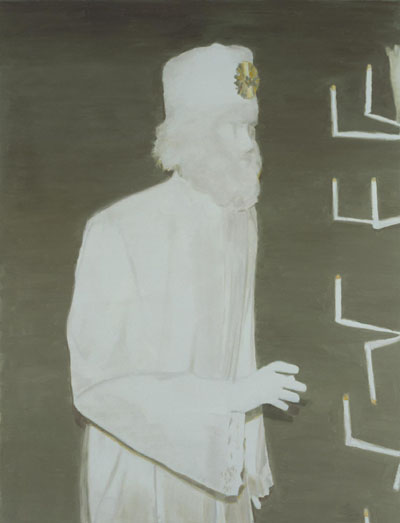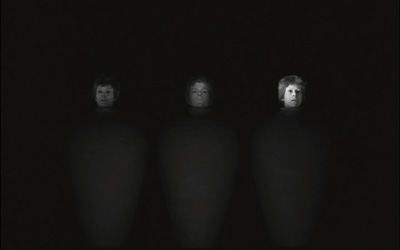 The Worshipper, 2004 Oel auf Leinwand, 193,0 x 147,5 cm Courtesy carlier | gebauer Luc Tuymans Les Cinq Anneaux Samuel Beckett / Marin Karmitz Comédie Click for English text Die Galerie carlier | gebauer zeigt neueste Arbeiten von Luc Tuymans unter dem Titel "Les Cinq Anneaux" und die Verfilmung von Samuel Becketts Theaterstück "Comédie (so der französische Titel von Stück und Film) in der Regie von Marin Karmitz in Zusammenarbeit mit Samuel Beckett aus dem Jahr 1966. Luc Tuymans ist einer der bedeutendsten und einflussreichsten Maler seiner Generation. Seine malerische Position hat er in der Mitte der 1980er Jahre entwickelt. In einer Zeit des Zweifels an der Darstellbarkeit setzte er beharrlich die figurative Malerei fort. Heute integriert er den Zweifel in seine künstlerische Strategie und lotet thematische, malerische und moralische Grenzen aus. Seine Motive beziehen sich auf politische und historische Ereignisse und führen dabei das Unmalbare aus. Daneben finden sich banale Motive des Alltags, der Biologie und Medizin, Detailbeobachtungen und Ausschnitte. Tuymans verwendet Fotos, Zeitungsabbildungen, Film- und Fernsehbilder als Vorlagen. Seine Malerei ahmt deren oft ausgeblichene, gealterte Farbigkeit und ihre spezifische Qualität nach. Das Interesse an der Abbildung zweiter Kategorie verbindet Tuymans mit der Frage nach den verschiedenen Möglichkeiten des Bildes und vor allem nach seinem Informations- und Wahrheitsgehalt. Das Unsagbare und das Unmalbare sind kompromisslos in seinen Arbeiten wieder zu finden. Tuymans nimmt eine distanzierte, skeptische Position gegenüber dem Vermögen und dem Versagen der Bilder ein und stellt den Betrachter vor die Frage, was bleibt vom Bilderstrom des 20. und 21. Jahrhunderts? carlier | gebauer zeigt "Les Cinq Anneaux" (Die Fünf Ringe) im Bogen 51. Zugleich ist es gelungen, mit der filmischen Koproduktion "Comédie" von Samuel Beckett und Marin Karmitz ein weiteres, grosses sprach- und bildskeptisches Werk des 20. Jahrhunderts zeigen zu können. Der französische Regisseur Marin Karmitz ist u.a. als Produzent der Filme "Drei Farben: Blau / Weiss / Rot" besonders hervorgetreten.  Samuel Beckett / Marin Karmitz: Comédie, 1966 copied on DVD, 35 mm film, 18 Min. 43 Sek., Edition of 10 Courtesy carlier | gebauer Karmitz hat zusammen mit Beckett 1966 auf der Filmbiennale in Venedig die Verfilmung von "Comédie" uraufgeführt. Der 19minütige Schwarzweissfilm handelt von drei Personen, zwei Frauen (F1 und F2) und einem Mann (H1), die sich dem inhaltlich banalen Parlando einer Dreiecksbeziehung hingeben. Ihre Körper stecken in Urnen, die nebeneinander in einem schwarzen Endlosraum aufgestellt sind, nur ihre Köpfe sind sichtbar. Ihre Gesichter sind weiss geschminkt, sie tragen diesselben Perücken und verziehen beim Sprechen keine Miene. Ihre Sprache ist ein Stakkato, das selbst für französische Muttersprachler unverständlich bleibt, ein Spot dirigiert, wer sprechen darf, indem er das Gesicht der Person hell erleuchtet. Der Film "Comédie" ist dabei kein abgefilmtes Theater, und dennoch bleibt er gänzlich unfilmisch: er verzichtet auf Handlung, Kameraführung, Dramaturgie. Der Inhalt bleibt verborgen und zwingt den Betrachter vor allem zum Sehen. Die noch als "all-over" wahrnehmbaren gesprochenen Sätze wurden in den Studios der GMR (Groupe de Recherche Musicales, Paris) von ihrem Nachhall und von ihren Pausen befreit. Die daraus entstehende Konzentration auf das "optical experience" (Beckett) - auf schnelle Schnitte, Zooms, Hell-Dunkelkontraste machen "Comédie" zu einem Meisterwerk der Moderne, das durch seine radikale Inszenierung weit in unsere heutige Zeit vorrausgegriffen hat. "Comédie" wird bei carlier | gebauer im Bogen 52 zu sehen sein. Ausstellungsdauer: 18.1. - 26.2.2005 Oeffnungszeiten: Di-Sa 11 - 18 Uhr Galerie carlier | gebauer Holzmarktstrasse 15-18, Bogen 51/52 D-10179 Berlin Telefon +49 30 280 81 10 Fax +49 30 280 81 09 Email office@carliergebauer.com www.carliergebauer.com Luc Tuymans Les Cinq Anneaux Samuel Beckett / Marin Karmitz Comédie Gallery carlier | gebauer is showing recent works by Luc Tuymans, entitled "Les Cinq Anneaux", and the 1966 film version of Samuel Beckett's play "Comédie" (the French title of the play and the film) directed by Marin Karmitz in cooperation with Samuel Beckett. Luc Tuymans is one of the most important and influential painters of his generation. He developed his painterly position in the mid-1980s. In an era that cast doubt on the possibilities of representation, he unwaveringly continued with figurative painting. Today he integrates the doubt into his artistic strategy and explores thematic, painterly and moral boundaries. His motifs relate to political and historical events, realizing the unpaintable in the process of considering these. Alongside these images one finds banal motifs from everyday life, biology and medicine, observations of details and excerpts. Tuymans takes as his starting point photos, reproductions in newspapers, film and TV images. His painting imitates the often faded, aged hues and the specific quality of these sources. Tuymans links an interest in second-degree depiction with the question of the various possibilities offered by the image and above all the issue of the information and truth it comprises. The unspeakable and the unpaintable are reflected uncompromisingly in his works. Tuymans adopts a distanced and sceptical position vis-à-vis the capacity and failure of images and asks the viewer what remains of the flood of images of the 20th and 21st centuries. carlier | gebauer is showing "Les Cinq Anneaux" (The Five Rings) in Arch 52. At the same time we have succeeded in showing a further major 20th-century work addressing scepticism about images and language, the film "Comédie", produced by Samuel Beckett in conjunction with Marin Karmitz. French director Marin Karmitz has made a name for himself, for example, as the producer of the films “Three Colours: Blue / White / Red”. Karmitz showed the world premiere of "Comédie" at the Film Biennale in Venice in 1966, together with Samuel Beckett. The 19-minute black and white film depicts three figures, two women (W1 and W2) and a man (M1), who busy themselves with the banal speech acts of a love triangle. Their bodies are contained in urns set next to each other in a black endless room; only their heads are visible. Their faces are covered in white makeup, they all wear the same wigs and are expressionless as they speak. Their language is a staccato utterance, incomprehensible even if one speaks French and a spotlight directs who may speak by illuminating the person's face. "Comédie" is not a film version of a play and yet it remains entirely uncinematic: it does without action, inematography, dramaturgy. The content remains concealed and compels the viewer above all to look. The sentences, which could still be perceived as "all-over", were treated by the GMR (Groupe de Recherche Musicales, Paris) to remove the echoes and pauses. The ensuing concentration on the "optical experience" (Beckett), on rapid cuts, zooms, and light-dark contrasts, make "Comédie" a masterpiece of modernity. Its radical staging meant it was far ahead of its time, and perhaps even of our time. "Comédie" can be seen at carlier | gebauer in Arch 51. January 18 - February 26, 2005 |